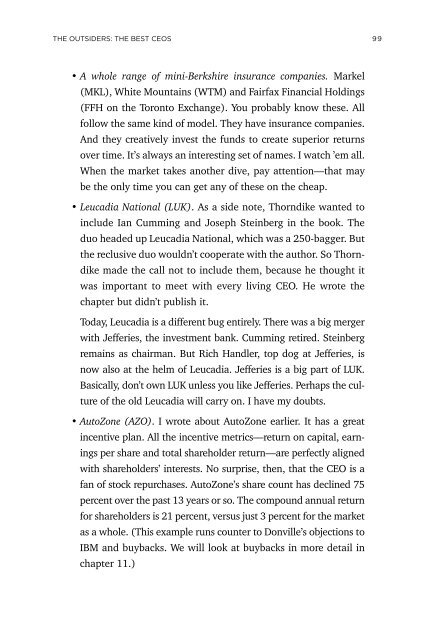You also want an ePaper? Increase the reach of your titles
YUMPU automatically turns print PDFs into web optimized ePapers that Google loves.
THE OUTSIDERS: THE BEST CEOS 99<br />
• A whole range of mini-Berkshire insurance companies. Markel<br />
(MKL), White Mountains (WTM) and Fairfax Financial Holdings<br />
(FFH on the Toronto Exchange). You probably know these. All<br />
follow the same kind of model. They have insurance companies.<br />
And they creatively invest the funds to create superior returns<br />
over time. It’s always an interesting set of names. I watch ’em all.<br />
When the market takes another dive, pay attention—that may<br />
be the only time you can get any of these on the cheap.<br />
• Leucadia National (LUK). As a side note, Thorndike wanted to<br />
include Ian Cumming and Joseph Steinberg in the book. The<br />
duo headed up Leucadia National, which was a 250-bagger. But<br />
the reclusive duo wouldn’t cooperate with the author. So Thorndike<br />
made the call not to include them, because he thought it<br />
was important to meet with every living CEO. He wrote the<br />
chapter but didn’t publish it.<br />
Today, Leucadia is a different bug entirely. There was a big merger<br />
with Jefferies, the investment bank. Cumming retired. Steinberg<br />
remains as chairman. But Rich Handler, top dog at Jefferies, is<br />
now also at the helm of Leucadia. Jefferies is a big part of LUK.<br />
Basically, don’t own LUK unless you like Jefferies. Perhaps the culture<br />
of the old Leucadia will carry on. I have my doubts.<br />
• AutoZone (AZO). I wrote about AutoZone earlier. It has a great<br />
incentive plan. All the incentive metrics—return on capital, earnings<br />
per share and total shareholder return—are perfectly aligned<br />
with shareholders’ interests. No surprise, then, that the CEO is a<br />
fan of stock repurchases. AutoZone’s share count has declined 75<br />
percent over the past 13 years or so. The compound annual return<br />
for shareholders is 21 percent, versus just 3 percent for the market<br />
as a whole. (This example runs counter to Donville’s objections to<br />
IBM and buybacks. We will look at buybacks in more detail in<br />
chapter 11.)


